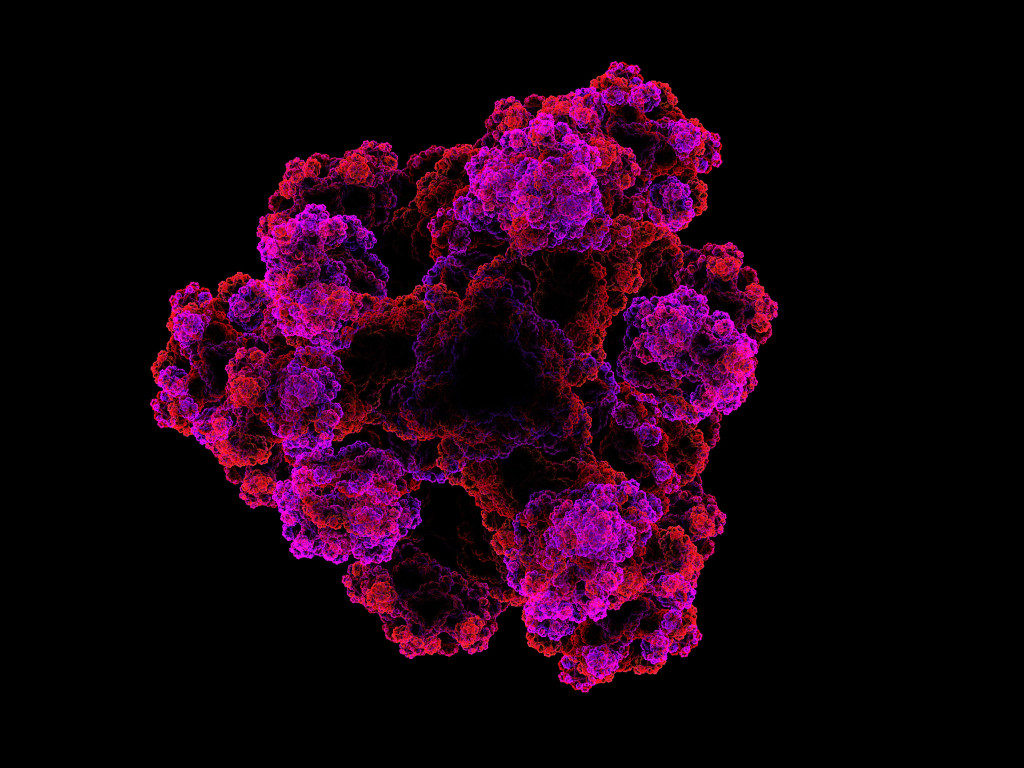Highlights
- •(PR)n peptides trigger a generalized accumulation of polysome-unbound r-proteins
- •(PR)n-resistant cells present low rates of ribosome biogenesis
- •mTOR inhibition or MYC depletion increases resistance to (PR)n peptides
- •(PR)97 expression accelerates aging in mice, which is alleviated by rapamycin
Summary
Nucleolar stress (NS) has been associated with age-related diseases such as cancer or neurodegeneration. To investigate how NS triggers toxicity, we used (PR)n arginine-rich peptides present in some neurodegenerative diseases as inducers of this perturbation. We here reveal that whereas (PR)n expression leads to a decrease in translation, this occurs concomitant with an accumulation of free ribosomal (r) proteins. Conversely, (PR)n-resistant cells have lower rates of r-protein synthesis, and targeting ribosome biogenesis by mTOR inhibition or MYC depletion alleviates (PR)n toxicity in vitro. In mice, systemic expression of (PR)97 drives widespread NS and accelerated aging, which is alleviated by rapamycin. Notably, the generalized accumulation of orphan r-proteins is a common outcome of chemical or genetic perturbations that induce NS. Together, our study presents a general model to explain how NS induces cellular toxicity and provides in vivo evidence supporting a role for NS as a driver of aging in mammals.
Introduction
Nucleoli are the largest membrane-less nuclear organelles, best known for their central role in ribosome biogenesis.1,2 Nevertheless, proteomic studies revealed that nucleoli harbor hundreds of proteins involved in multiple additional functions3 such as DNA repair and recombination, telomere maintenance, or stress responses (reviewed in Iarovaia et al.4). The nucleolus is primarily formed by phase separation, driven by low-affinity interactions between ribosomal DNA (rDNA) and/or ribosomal RNA (rRNA) with nucleolar factors. The accumulation of proteins at nucleoli is mediated by nucleolar localization sequences, from which more than 50% of the amino acids are positively charged lysines and arginines.5,6 First noted in 1985,7 nucleolar proteins often change their localization upon various forms of stress, and this redistribution is interpreted as indicative of nucleolar stress (NS). Today, NS collectively refers to a wide range of chemical or genetic perturbations that target nucleoli and alter their shape and function.8,9 Examples of NS-inducers include RNA polymerase I (RNA Pol I) inhibitors,7 viral proteins,10 UV light,11 heat shock,12 and DNA-damaging drugs.13,14 Regardless of the insult, NS triggers the activation of P53, even in the absence of DNA damage.15 Importantly, however, numerous evidences indicate that although P53 contributes to NS-driven toxicity, this stress ultimately kills cells by p53-independent mechanisms that remain to be deciphered.16
In addition to exogenous sources that cause NS, nucleolar alterations have been frequently documented in human disease.17 For instance, aberrations in nucleolar shape and number are associated to poor prognosis in several cancer types,18 and mutations or altered expression of r-proteins are often found in cancer cells.19,20 Accordingly, strategies targeting nucleoli are being actively investigated as anti-cancer therapies.21 Besides cancer, NS has been particularly associated to neurodegenerative diseases, perhaps due to the higher translational demand of neurons when compared with that of other cell types.22 In this regard, NS-inducing arginine-rich dipeptide repeats (DPRs), such as (PR)n or (GR)n, have been found in patients of amyotrophic lateral sclerosis and spinocerebellar ataxia type 36, driven by mutations in C9ORF72 and SCA36, respectively.23 These DPRs accumulate at nucleoli, disrupt nucleolar function, and lead to cell death.24 Yet again, even if several manuscripts have reported a distinct effect of arginine-rich peptides at nucleoli,24,25,26,27,28,29 a full understanding of how the NS triggered by DPRs leads to cellular toxicity is still lacking.
Finally, and despite not being included as one of the “hallmarks of aging,”30 numerous evidences indicate a role for NS in aging.31 Early studies in yeast revealed that rDNA instability accumulates during an organism’s lifespan and already suggested that safeguarding nucleolar function could be a life-extending strategy.32,33 Accordingly, some of the central modulators of longevity, such as the mammalian target of rapamycin (mTOR) kinase, are key regulators of ribosome biogenesis and r-protein synthesis.34,35 More recently, nucleolar size was shown to be inversely correlated with lifespan in several organisms, and depletion of the nucleolar factor fibrillarin (FBL) shrank nucleoli and extended survival in C. elegans.36 In mammals, NS can drive cellular senescence in vitro,37 and nucleoli were shown to be enlarged in cells from Hutchinson-Gilford progeria syndrome patients.38 Despite these studies, direct proof to demonstrate that NS accelerates aging in an adult animal is still missing. Here, using (PR)n peptides as a tool to induce NS, we set out to investigate the mechanisms of NS toxicity and its impact on mammalian lifespan.
Section snippets
(PR)97 expression drives the accumulation of polysome-unbound r-proteins
To investigate the mechanisms mediating the toxicity of arginine-rich peptides, we generated a human osteosarcoma U2OS cell line that enabled doxycycline (dox)-inducible expression of an hemagglutinin (HA)-tagged (PR)97 polypeptide (U2OS(PR)97). We chose U2OS as this cell line was originally used by the McKnight laboratory to illustrate the toxicity of (PR)n and (GR)n peptides.24 Consistent with their study, (PR)97 peptides accumulated at nucleoli, triggered NS, and killed cells (Figures 1
Discussion
Ribosome biogenesis is the most energy-demanding activity in a cell.56 As a consequence, perturbing nucleolar function can have a profound impact on cell fitness and/or viability. Correspondingly, abnormalities in nucleolar activity or structure, now collectively known as NS, have often been found in tissues from patients of several human diseases such as ribosomopathies, cancer, or neurodegeneration.17 Very recent work added brachyphalangy, polydactyly, and tibial aplasia/hypoplasia syndrome.







